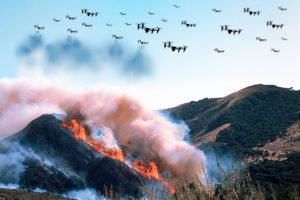
Are drone swarms for firefighting the future of fire supression? New work from engineer and mathematician Elena Ausonio and a team of Italian researchers suggests that they could be.
The following is a guest post by Max Lenz, Executive Editor and project manager at the Berlin-based DroneMasters Boost GmbH and editor of the weekly DroneMasters Briefing. DRONELIFE neither makes nor accepts payment for guest posts.
Drone Swarms for Firefighting
Wildland fires are a growing problem in various regions of the world. Due to climate change and changing landscape conditions, there is an increase in fire risk and more frequent forest fires with significant impacts on nature and people. Almost all continents have experienced large fires in recent years that were impossible or difficult to control using conventional firefighting methods.
Elena Ausonio from the Department of Mechanical Engineering (DIME) at the University of Genoa, together with Patrizia Bagnerini and Marco Ghio, has researched the use of drone swarms for forest firefighting. Elena holds a master’s degree in Civil and Architectural Engineering and has researched geomatics, photogrammetry, and digital numerical cartography. Since 2018, she is a Ph.D. student in Mathematical and Simulation Engineering at the University of Genoa in Italy, in collaboration with the spinoff Inspire (www.inspire.flights). She enthusiastically follows developments in drones and automated systems and is a certified drone pilot herself. We talked to her about her work to learn more about the potential of drones in this field.
The paper, Drone Swarms in Fire Suppression Activities: A Conceptual Framework, outlines how drones could fight wildfires or support conventional firefighting methods. The researchers propose a system consisting of a swarm of drones, each capable of carrying a payload between 5 and 50 kilograms. The drones would function as a unified system, following a grid network to perform their individual tasks. In this regard, the drone swarm has significant advantages over conventional aerial firefighting methods, such as helicopters or airplanes, as Elena Ausonio describes:
“A drone swarm using a relocatable servicing platform could be instantly deployed enabling a quick response and used both during the day and at night, in all visibility conditions, without the requirement of a nearby available water basin. Consider that in most countries, for safety reasons, firefighting aircraft can only fly during the day and are able to perform a limited number of water drops per hour due to the distance from a water refueling site.
Another essential feature is that a drone swarm is a true unmanned solution: drones do not risk the lives of aircraft pilots and firefighting crews, who often have to operate in conditions of considerable danger. It is a precise and flexible system because flight plans, targeted areas, etc., can be accurately outlined and modified in real-time as the conditions of the fire evolve. Last but not least, a drone swarm-based solution can easily be scaled to meet specific emergency needs.”
In addition, the drone swarm could take advantage of the so-called rain effect. Because evaporation of water contributes significantly to extinguishment, the distributed use of firefighting water can do more than a spot drop. This rain effect can be simulated by the many small units of a swarm.
Technical challenges
For a functional drone swarm to be used effectively for firefighting, complex requirements must be met. In addition to the drones successfully working together, it must also be possible to charge or replace the drones’ batteries automatically and successfully refuel them with extinguishing liquid. Then there is the rapid deployment of the swarm of drones in a mobile unit, such as a truck or a base station near a wildfire area.
Ausonio is confident that these challenges can be overcome in the future, “Technology is evolving further every day. An autonomous firefighting system requires a combination of technologies, including computer vision, artificial intelligence, object avoidance, fire-resistant materials, and a fast servicing mechanism. At this time, we continue our research by studying hybrid drones that could provide greater effectiveness and efficiency in transporting water and extinguishing liquids. I, Inspire, and the research group at the University of Genoa continue to improve our platform-drone system and hope that major players understand that it is possible and feasible in the very near future to use drones for forest firefighting.”

Looking to the future
All in all, the study paints a positive picture for the future use of drone swarms for wildland firefighting. Automated drone swarms would be quick and flexible to deploy and could help contain the fire quickly, especially for smaller fires. It is also quite conceivable that the swarms could be used to supplement conventional firefighting methods.
Ausonio is optimistic about the future and hopes to see more research in this area, “I am sure that drones, small, medium, and large, are the future of forest firefighting. Certainly, many studies and experiments are still necessary, but for me, the great advantages that their use can provide are evident. In the past few years, there has been a significant technological advancement that suggests we will see drone swarms putting out fires within this decade.”
It could well be that the use of drone swarms to fight forest and brush fires could be just the beginning of a transformation in firefighting. Finally, we wanted to know from Elena Ausonio how she sees the use of drone swarms to fight fires in urban areas:
“I envision the use of firefighting drones in cities and in urbanized and populated areas. I think they would be very well suited for dealing with fires in constructions, particularly on the upper floors of buildings where firefighters with their ground vehicles would have more trouble operating. Drones could not only extinguish the flames inside the rooms closest to the perimeter openings on the facades but also bring firefighting support material to those who may have been trapped in the building, such as fire blankets or parachutes.
They would also be a valuable tool in case of fires to vulnerable structures that could not withstand high overloads, such as the weight of water drops from helicopters and Canadairs. For example, I am thinking of the fire that destroyed the La Fenice Theater in Venice in 1996 and the fire at Notre Dame de Paris in 2019. Some companies and start-ups experimenting in this field have already made their first attempts, but the system we hypothesized, thanks to its autonomy, could respond quickly to requests for intervention and act continuously and efficiently.”
Those of you who would like to gain further insights into the topic or have specific questions are welcome to attend the 56th DroneMasters Meetup (online) on 5 May 2020. Among three other inspiring speakers from the drone industry, Elena Ausonio will present her research and answer questions. At the DroneMasters Meetups, experts and enthusiasts from various fields share ideas and experiences to shape the sustainable use of drones.
Max Lenz is Executive Editor and project manager at the Berlin-based DroneMasters Boost GmbH, an incubator and consultancy focusing on vertical mobility and drones. As editor of the weekly DroneMasters Briefing, Max monitors advancements in vertical mobility and highlights exciting developments. At the DroneMasters Academy he provides access to aerial robotics, aviation, science, tech, engineering, and math (STEM) using drones and drone sports.








[…] says Elena Ausonio, a professor of mechanical engineering on the College of Genoa, in an April interview in DroneLife.com. Those craft may perform day and night time, in heavy smoke and with out the […]